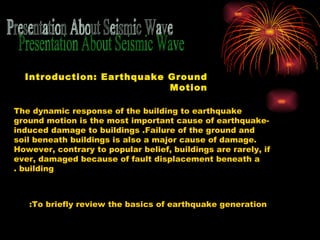
Presentation about seismic wave
- 1. Presentation About Seismic Wave Introduction: Earthquake Ground Motion The dynamic response of the building to earthquake ground motion is the most important cause of earthquake - induced damage to buildings . Failure of the ground and soil beneath buildings is also a major cause of damage . However, contrary to popular belief, buildings are rarely, if ever, damaged because of fault displacement beneath a building . To briefly review the basics of earthquake generation:
- 3. 3/ The seismic waves travel for great distances before finally losing most of their energy. Figure 2 illustrates some of the basic features common not only to seismic waves but to all forms of wave motion. figure 2 At some time after their generation, these seismic waves will reach the earth's surface, and set it in motion, which we not surprisingly refer to as earthquake ground motion. When this earthquake ground motion occurs beneath a building and when it is strong enough, it sets the building in motion, starting with the building's foundation, and transfers the motion throughout the rest of the building in a very complex way. These motions in turn induce forces which can produce damage.
- 4. The complexity of earthquake ground motion is due to three factors: 1/ The seismic waves generated at the time of earthquake fault movement were not all of a uniform character . 2/ As these waves pass through the earth on their way from the fault to the building site, they are modified by the soil and rock media through which they pass . 3/ Once the seismic waves reach the building site they undergo further modifications that are dependent upon the characteristics of the ground and soil beneath the building. We refer to these three factors as source effects, path effects, and local site effects .
- 5. Ground Motion And Building Frequencies The characteristics of earthquake ground motions which have the greatest importance for buildings are the duration, amplitude (of displacement, velocity and acceleration) and frequency of the ground motion. Frequency is defined as the number of complete cycles of vibration made by the wave per second Here, we can consider a complete vibration to be the same as the distance between one crest of the wave and the next, in other words one full wavelength. (See Figure 2 above.) Frequency is often measured in units called Hertz. Thus, if two full waves pass in one second, the frequency is 2 hertz (abbreviated as 2 Hz). Building Frequency and Period
- 6. Another way to understand this is to think of the building's response in terms of another important quantity, the building's natural period. The building period is simply the inverse of the frequency: Whereas the frequency is the number of times per second that the building will vibrate back and forth, the period is the time it takes for the building to make one complete vibration. The relationship between frequency f and period T is thus very simple math:
- 7. Resonant Frequencies When the frequency contents of the ground motion are centered around the building's natural frequency, we say that the building and the ground motion are in resonance with one another. Resonance tends to increase or amplify the building's response. Because of this, buildings suffer the greatest damage from ground motion at a frequency close or equal to their own natural frequency. figure 3 Response Spectra
- 8. As we've just seen, different buildings can respond in widely differing manners to the same earthquake ground motion. Conversely, any given building will act differently during different earthquakes, which gives rise to the need of concisely representing the building's range of responses to ground motion of different frequency contents. Such a representation is known as a response spectrum. A response spectrum is a kind of graph which plots the maximum response values of acceleration, velocity and displacement against period and frequency. Response spectra are very important "tools" in earthquake engineering.
- 9. إعداد / أحمد أمين محمد أحمد بركات